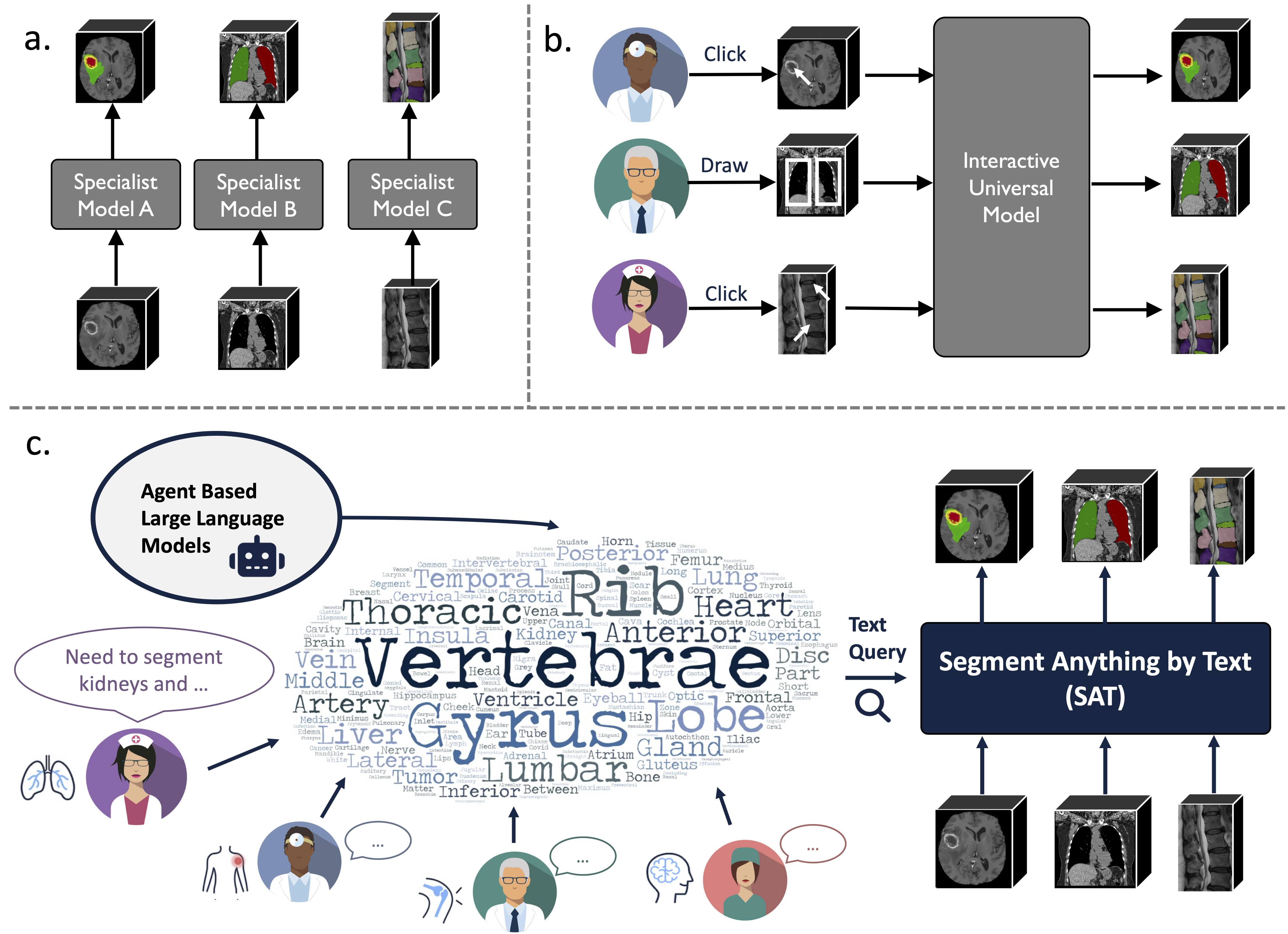This is the official repository for "One Model to Rule them All: Towards Universal Segmentation for Medical Images with Text Prompts" 🚀
It's a knowledge-enhanced universal segmentation model built upon an unprecedented data collection (72 public 3D medical segmentation datasets), which can segment 497 classes from 3 different modalities (MR, CT, PET) and 8 human body regions, prompted by text (anatomical terminology).
It can be powerful and more efficient than training and deploying a series of specialist models. Find more on our website or paper.
-
2024.08 📢 Based on SAT and large language models, we build a comprehensive, large-scale and region-guided 3D chest CT interpretation dataset. It contains organ-level segmentation for 196 categories, and multi-granularity reports, where each sentence is grounded to the corresponding segmentation. Check it on huggingface.
-
2024.06 📢 We have released the code to build SAT-DS, a collection of 72 public segmentation datasets, contains over 22K 3D images, 302K segmentation masks and 497 classes from 3 different modalities (MRI, CT, PET) and 8 human body regions, upon which we build SAT. We also offer shortcut download links for 42/72 datasets, which are preprocessed and packaged by us for your convenience, ready for immediate use upon download and extraction. Check this repo for details.
-
2024.05 📢 We train a new version of SAT with larger model size (SAT-Pro) and more datasets (72), and it supports 497 classes now! We also renew SAT-Nano, and release some variants of SAT-Nano, based on different visual backbones (U-Mamba and SwinUNETR) and text encoders (MedCPT and BERT-Base). For more details about this update, refer to our new paper.
The implementation of U-Net relies on a customized version of dynamic-network-architectures, to install it:
cd model
pip install -e dynamic-network-architectures-main
Some other key requirements:
torch>=1.10.0
numpy==1.21.5
monai==1.1.0
transformers==4.21.3
nibabel==4.0.2
einops==0.6.1
positional_encodings==6.0.1
You also need to install mamba_ssm if you want the U-Mamba variant of SAT-Nano
-
S1. Build the environment following
requirements.txt. -
S2. Download checkpoint of SAT and Text Encoder from huggingface.
-
S3. Prepare the data in a jsonl file. Check the demo in
data/inference_demo/demo.jsonl.-
image(path to image),labe(name of segmentation targets),dataset(which dataset the sample belongs to) andmodality(ct, mri or pet) are needed for each sample to segment. Modalities and classes that SAT supports can be found in in Table 12 of the paper. -
orientation_code(orientation) isRASby default, which suits most images in axial plane. For images in sagittal plane (for instance, spine examination), set this toASR. The input image should be with shapeH,W,DOur data process code will normalize the input image in terms of orientation, intensity, spacing and so on. Two successfully processed images can be found indemo\processed_data, make sure the normalization is done correctly to guarantee the performance of SAT.
-
-
S4. Start the inference with SAT-Pro 🕶:
torchrun \ --nproc_per_node=1 \ --master_port 1234 \ inference.py \ --rcd_dir 'demo/inference_demo/results' \ --datasets_jsonl 'demo/inference_demo/demo.jsonl' \ --vision_backbone 'UNET-L' \ --checkpoint 'path to SAT-Pro checkpoint' \ --text_encoder 'ours' \ --text_encoder_checkpoint 'path to Text encoder checkpoint' \ --max_queries 256 \ --batchsize_3d 2⚠️ NOTE:--batchsize_3dis the batch size of input image patches, and need to be adjusted based on the gpu memory (check the table below);--max_queriesis recommended to set larger than the classes in the inference dataset, unless your gpu memory is very limited;Model batchsize_3d GPU Memory SAT-Pro 1 ~ 34GB SAT-Pro 2 ~ 62GB SAT-Nano 1 ~ 24GB SAT-Nano 2 ~ 36GB -
S5. Check
--rcd_dirfor outputs. Results are organized by datasets. For each case, the input image, aggregated segmentation result and a folder containing segmentations of each class will be found. All outputs are stored as nifiti files. You can visualize them using the ITK-SNAP. -
If you want to use SAT-Nano trained on 72 datasets, just modify
--vision_backboneto 'UNET', and change the--checkpointand--text_encoder_checkpointaccordingly. -
For other SAT-Nano variants (trained on 49 datasets):
UNET-Ours: set
--vision_backbone 'UNET'and--text_encoder 'ours';UNET-CPT: set
--vision_backbone 'UNET'and--text_encoder 'medcpt';UNET-BB: set
--vision_backbone 'UNET'and--text_encoder 'basebert';UMamba-CPT: set
--vision_backbone 'UMamba'and--text_encoder 'medcpt';SwinUNETR-CPT: set
--vision_backbone 'SwinUNETR'and--text_encoder 'medcpt';
Some preparation before start the training:
- you need to build your training data following this repo, a jsonl containing all the training samples is required.
- you need to fetch the text encoder checkpoint from https://huggingface.co/zzh99/SAT to generate prompts.
Our recommendation for training SAT-Nano is 8 or more A100-80G, for SAT-Pro is 16 or more A100-80G. Please use the slurm script in
sh/to start the training process. Take SAT-Pro for example:
sbatch sh/train_sat_pro.sh
- Inference demo on website.
- Release the data preprocess code to build SAT-DS.
- Release the train guidance.
If you use this code for your research or project, please cite:
@arxiv{zhao2023model,
title={One Model to Rule them All: Towards Universal Segmentation for Medical Images with Text Prompt},
author={Ziheng Zhao and Yao Zhang and Chaoyi Wu and Xiaoman Zhang and Ya Zhang and Yanfeng Wang and Weidi Xie},
year={2023},
journal={arXiv preprint arXiv:2312.17183},
}





